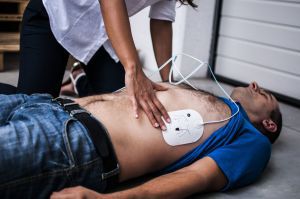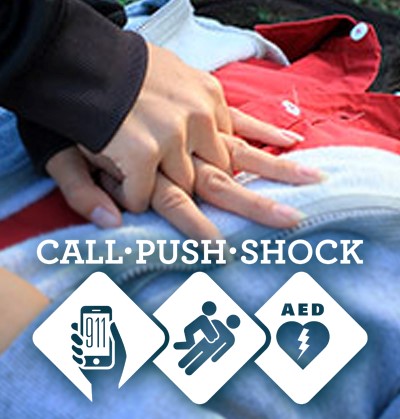
The annual report indicates the incidence of out-of-hospital cardiac arrest (OHCA) in the U.S. remains high and survival remains low. Bystander intervention in the U.S. also remains low. In 2017, laypersons initiated CPR in 39% of cases, used AEDs in just 6% of cases, and delivered a shock in ~2% of cases, based on CARES data.
There are more than 356,000 out-of-hospital cardiac arrests (OHCA) annually in the U.S., nearly 90% of them fatal, according to the American Heart Association’s newly released Heart and Stroke Statistics—2019 Update.[1] According to the report, the incidence of EMS-assessed non-traumatic OHCA in people of any age is estimated to be 356,461, or nearly 1,000 people each day. Survival to hospital discharge after EMS-treated cardiac arrest is about 10%.
There are a number of ongoing challenges to understanding the epidemiology of cardiac arrest[2] in the U.S. Despite being a leading cause of death, there are currently no nationwide standards for surveillance to monitor the incidence and outcomes of cardiac arrest. Thus, registries and clinical trials are used to provide best estimates. These sources include the Resuscitation Outcomes Consortium (ROC), 2005-2015, and the ongoing Cardiac Arrest Registry to Enhance Survival (CARES).
Following are selected highlights from the 2019 report.
|
Annual Incidence of EMS-Assessed OHCA |
|
|
Any age |
356,461 |
|
Adults |
347,322 |
|
Children |
7,037 |
Adults
- Estimates suggest the incidence of OHCA among adults is 347,322.
- The location of OHCA in adults is most often a home or residence (69.5%), a public setting (18.8%), or a nursing home (11.7%).
- OHCA in adults is witnessed by a layperson in 37% of cases or by an EMS provider in 12% of cases. For 51% of cases, OHCA is not witnessed.
- Survival to hospital discharge after EMS-treated cardiac arrest was 10.4% and survival with good functional status was 8.4%, based on CARES data for 2017.[3]
- Survival to hospital discharge after EMS-treated cardiac arrest was 11.4%, based on ROC data.[4]
- Large regional variations in survival to hospital discharge (range, 3.4%-22%) and survival with functional recovery (range, 0.8%-20.1%) are observed in 132 counties in the U.S. Variations in the rates of layperson CPR and AED use explained much of this variation.
- Among adults treated by EMS, 25% had no symptoms before the onset of arrest.
- The initial recorded cardiac rhythm was VF (ventricular fibrillation) or VT (ventricular tachycardia), i.e., shockable by an AED in 18.7% of EMS-treated OHCAs in 2017.
Children
- Estimates suggest the incidence of EMS-assessed OHCA among children (<18 years of age) is 7,037.
- The location of EMS-treated OHCA was at home for 90.6% of children <1 year old, 80.2% of children 1-12 years old, and 74.7% for children 13-18 years old in the CARES 2017 data. The location was a public place for 9.3% of children < 1 year old, 19.6% of children 1 to 12 years old, and 25% of children 13-18 years old.
- Survival to hospital discharge was 10.7% among children (8.2% with good neurological function).
- The incidence of non-traumatic OHCA was 1 per 43,770 athlete participant-years among students 17-24 years old participating in NCAA sports from 2004-2008. The incidence of cardiac arrest was higher among blacks than among whites and among males than among females.
|
Characteristics of and Outcomes for OHCA |
|
|
|
|
Adults |
Children |
|
Survival to hospital discharge |
10.4 |
11.1 |
|
Good functional status at hospital discharge |
8.4 |
9.9 |
|
VF/VT shockable |
18.7 |
8.0 |
|
Public setting |
18.8 |
14.6 |
|
Home |
69.5 |
85.3 |
|
Nursing home |
11.7 |
0.1 |
Sports-Related SCA-SCD
- The incidence of SCA was 0.54 per 100,000 participants among 10.9 million participants in 40 marathons and 19 half-marathons. Those with cardiac arrest were more often male and were running a marathon vs. a half-marathon.
- Among runners with cardiac arrest during marathons or half-marathons, 71% died. Those who died were younger than those who did not die (~39 vs. 49 years old), were more often male and were more often running a full-marathon.
- Sports-related SCA accounted for 39% of SCAs for ages <18 years, 13% for ages 19-25 years, and 7% for ages 25 to 34 years in a prospective registry of 3,775 SCAs in Portland, Oregon, between 2002-2015.
- The incidence of SCA during competitive sports in people 12 to 45 years old was 0.76 per 100,000 athlete-years in a population-based registry of paramedic responses in Toronto, Canada from 2009-2014.
- In the U.S. National Registry of Sudden Death in Athletes from 1980-2011, there were 1,306 SCDs in young athletes (mean 19+6 years of age) participating in organized sports. The most common causes of SCD among young athletes are hypertrophic cardiomyopathy (36%), coronary artery abnormalities (19%), myocarditis (7%), arrhythmogenic right ventricular cardiomyopathy (5%), coronary artery disease (4%), and commotio cordis (3%).
Risks
- A large proportion of OHCA in the general population results from coronary artery disease (CAD). Risk factors are thus similar to CAD.
- Arrhythmic cardiac arrest not attributable to CAD is associated with structural heart disease in about one-third of cases and primary arrhythmic disorders, often with a genetic basis, in the other two-thirds of cases.
- A family history of cardiac arrest in a first-degree relative is associated with an ~2-fold increased risk of cardiac arrest.
- SCD appears among the multiple causes of death on 13.4% of death certificates, which suggests that 1 of every 7.5 people in the U.S. will die of SCD.
- Infants have a higher risk of SCD (12.8 per 100,000) than older children 1.1-2.0 per 100,000) Among adults, the risk of SCD increases exponentially with age, surpassing the risk for infants by age 40 (20.3 per 100,000).
Trends
- Unadjusted survival to hospital discharge after EMS-treated OHCA increased from 10.2% in 2006 to 12.4% in 2015.
- Rates of layperson-initiated CPR and layperson use of AEDs have increased slightly over time. In 2017, laypersons initiated CPR in 39.4% of cases, used AEDs in 6% of cases, and delivered a shock in 1.6% of cases, based on CARES data.
Complications
- Survivors of cardiac arrest experience multiple medical problems including impaired consciousness and cognitive deficits. As many as 18% of OHCA survivors have moderate to severe functional impairment at hospital discharge.
- Functional recovery continues over at least the first 12 months after OHCA in children and over the first six to 12 months after OHCA in adults.
Healthcare Utilization and Cost
- The estimated societal burden of SCD in the U.S. was 2 million years of potential life lost for males and 1.3 million potential life lost for females, accounting for 40-50% of the years of potential life lost from all cardiac diseases.
- Among males, estimated deaths attributed to SCD exceeded all other individual causes of death, including lung cancer, accidents, chronic lower respiratory disease, cerebrovascular disease, diabetes mellitus, prostate cancer, and colorectal cancer.
Awareness and Treatment
- The median annual CPR training rate for U.S. counties was 2.39%, based on data from the AHA, American Red Cross and the Health & Safety Institute, the largest providers of CPR training in the U.S. Training rates were lower in rural areas, areas with high proportions of black or Hispanic residents, and counties with lower median household incomes.
- The prevalence of reported current CPR training was 18%, and the prevalence of having CPR training at some point was 65%.
Future Research
- The absence of standards for monitoring and reporting the incidence and outcomes of cardiac arrest remains a barrier to population research in the U.S. Increasing the rigor of reporting cardiac arrest will improve understanding of the epidemiology of this syndrome.
ORIGINAL SOURCE: American Heart Association; Summary compiled by Mary Newman, MS, Sudden Cardiac Arrest Foundation
[1] Benjamin EM, et al. Heart Disease and Stroke Statistics—2019 Update. A Report from the American Heart Association. Circulation. 2019;139:00. DOI:10.1161/CIR.000000000000659
[2] “Cardiac arrest is the cessation of cardiac mechanical activity, as confirmed by the absence of circulation,” according to the report. “SCA (Sudden Cardiac Arrest) is unexpected cardiac arrest that might result in attempts to restore circulation. If attempts are unsuccessful, this situation is referred to as SCD” (Sudden Cardiac Death).
